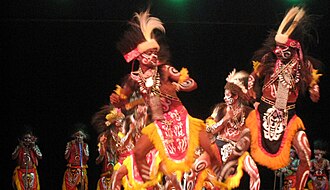War dance


War dance refers to any dance that is performed by a group of people to express their readiness for war, to intimidate the enemy, or to celebrate victories. War dances have been a part of many cultures throughout history, serving not only as a martial exercise but also as a ritual to boost morale and invoke the protection of deities. These dances vary greatly across different cultures, each with its unique steps, costumes, and music, reflecting the traditions and beliefs of their people.
History and Significance[edit]
The tradition of war dances can be traced back to ancient civilizations. In many societies, these dances were believed to imbue warriors with strength, courage, and the favor of the gods. For example, the Maori people of New Zealand perform the Haka, a traditional war dance known for its powerful display of a tribe's pride, strength, and unity. Similarly, Native American tribes have their own versions of the war dance, each with specific movements and meanings, often performed during powwows or other ceremonial gatherings.
Cultural Examples[edit]
Maori Haka[edit]
The Haka is perhaps one of the most internationally recognized war dances, performed by the Maori people of New Zealand. It involves vigorous movements, stamping of the feet with rhythmically shouted accompaniment. While it was originally performed by warriors before a battle, today, it is also performed to welcome distinguished guests, at celebrations, and on significant occasions.
Native American War Dances[edit]
Native American war dances often involve elaborate costumes and are accompanied by drums and vocal chanting. These dances serve multiple purposes, including psyching up the warriors for battle, telling stories, and honoring those who have fallen.
Zulu War Dance[edit]
The Zulu war dance, performed by the Zulu tribe of South Africa, is another example. Known as the Indlamu, this dance mimics the movements of warfare, with dancers wielding traditional weapons like spears and shields. It is characterized by high kicks and rhythmic movements that display the dancer's strength and stamina.
Modern Interpretations[edit]
In contemporary times, war dances are less about preparation for actual combat and more about preserving cultural heritage, performing during cultural festivals, and in competitive dance. However, some military units still perform traditional war dances to boost morale and maintain a connection with their historical roots.
Conclusion[edit]
War dances are a fascinating aspect of cultural heritage, offering insight into the martial traditions, values, and social structures of different societies. They remind us of the human capacity for both conflict and artistry, serving as a powerful expression of identity and unity.
Ad. Transform your life with W8MD's Budget GLP-1 injections from $75


W8MD offers a medical weight loss program to lose weight in Philadelphia. Our physician-supervised medical weight loss provides:
- Weight loss injections in NYC (generic and brand names):
- Zepbound / Mounjaro, Wegovy / Ozempic, Saxenda
- Most insurances accepted or discounted self-pay rates. We will obtain insurance prior authorizations if needed.
- Generic GLP1 weight loss injections from $75 for the starting dose.
- Also offer prescription weight loss medications including Phentermine, Qsymia, Diethylpropion, Contrave etc.
NYC weight loss doctor appointmentsNYC weight loss doctor appointments
Start your NYC weight loss journey today at our NYC medical weight loss and Philadelphia medical weight loss clinics.
- Call 718-946-5500 to lose weight in NYC or for medical weight loss in Philadelphia 215-676-2334.
- Tags:NYC medical weight loss, Philadelphia lose weight Zepbound NYC, Budget GLP1 weight loss injections, Wegovy Philadelphia, Wegovy NYC, Philadelphia medical weight loss, Brookly weight loss and Wegovy NYC
|
WikiMD's Wellness Encyclopedia |
| Let Food Be Thy Medicine Medicine Thy Food - Hippocrates |
Medical Disclaimer: WikiMD is not a substitute for professional medical advice. The information on WikiMD is provided as an information resource only, may be incorrect, outdated or misleading, and is not to be used or relied on for any diagnostic or treatment purposes. Please consult your health care provider before making any healthcare decisions or for guidance about a specific medical condition. WikiMD expressly disclaims responsibility, and shall have no liability, for any damages, loss, injury, or liability whatsoever suffered as a result of your reliance on the information contained in this site. By visiting this site you agree to the foregoing terms and conditions, which may from time to time be changed or supplemented by WikiMD. If you do not agree to the foregoing terms and conditions, you should not enter or use this site. See full disclaimer.
Credits:Most images are courtesy of Wikimedia commons, and templates, categories Wikipedia, licensed under CC BY SA or similar.
Translate this page: - East Asian
中文,
日本,
한국어,
South Asian
हिन्दी,
தமிழ்,
తెలుగు,
Urdu,
ಕನ್ನಡ,
Southeast Asian
Indonesian,
Vietnamese,
Thai,
မြန်မာဘာသာ,
বাংলা
European
español,
Deutsch,
français,
Greek,
português do Brasil,
polski,
română,
русский,
Nederlands,
norsk,
svenska,
suomi,
Italian
Middle Eastern & African
عربى,
Turkish,
Persian,
Hebrew,
Afrikaans,
isiZulu,
Kiswahili,
Other
Bulgarian,
Hungarian,
Czech,
Swedish,
മലയാളം,
मराठी,
ਪੰਜਾਬੀ,
ગુજરાતી,
Portuguese,
Ukrainian
